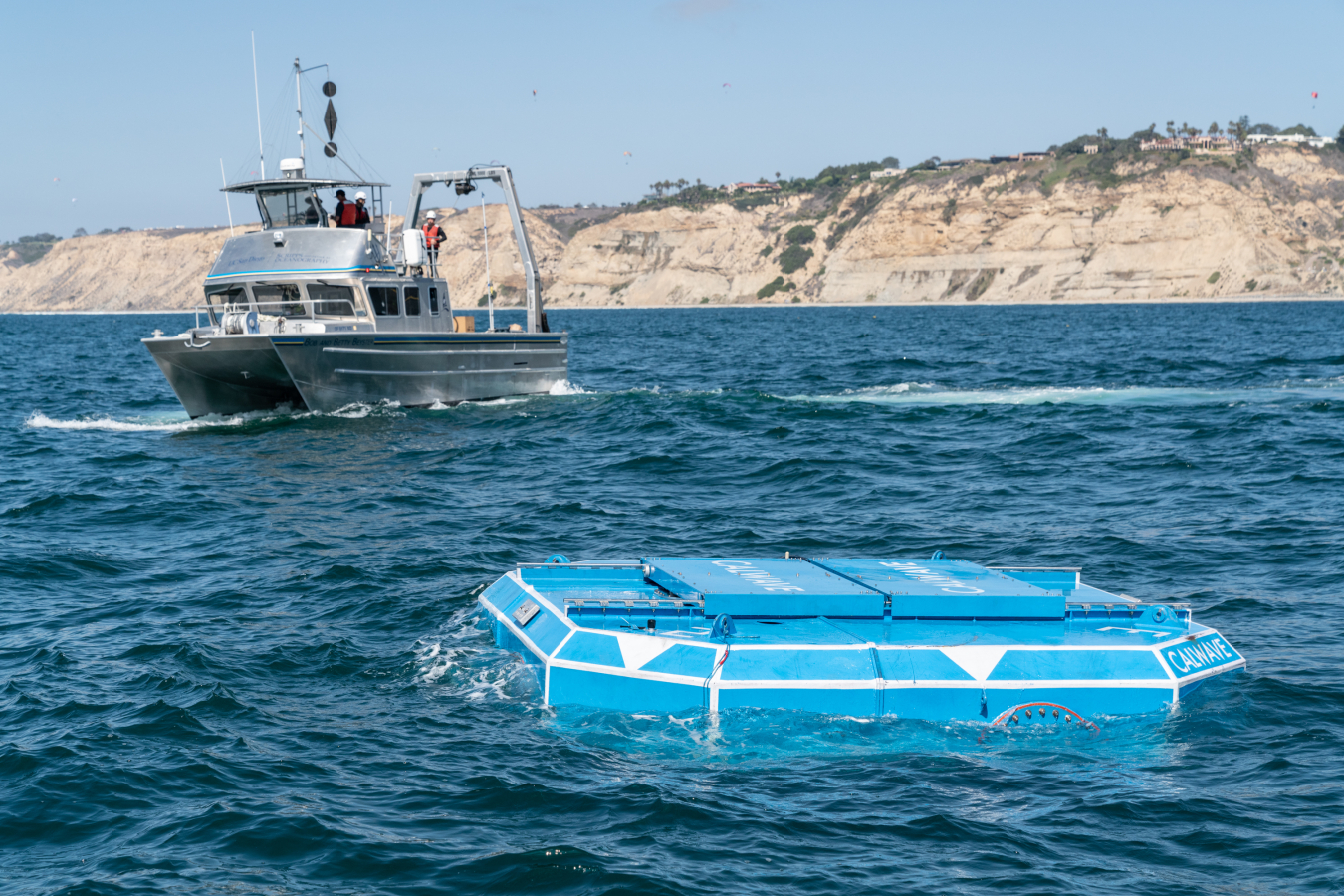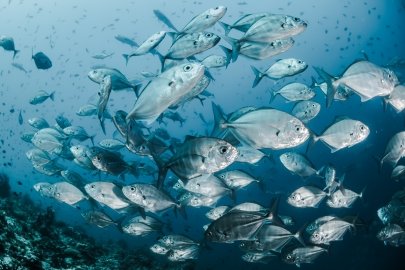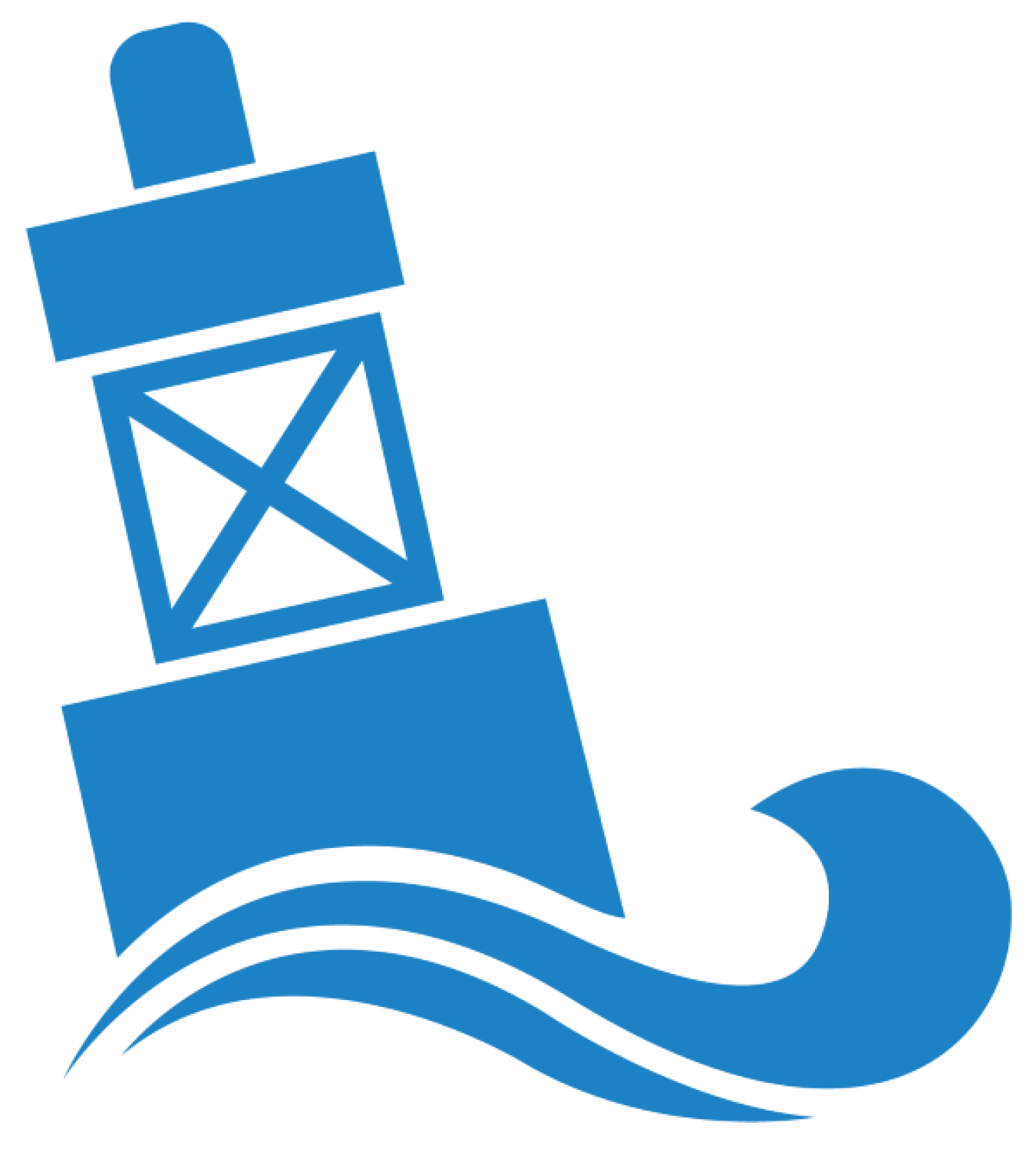During CalWave’s 10-month open-water test off the California coast, its wave energy converter technology remained operational for 99% of the deployment, and the company collected valuable data on device-ecosystem interactions.
Water Power Technologies Office
March 1, 2023Marine Energy Program
Technology-Specific System Design and Validation
Project Name: CalWave Open-Water Demonstration
Project Team: CalWave Power Technologies, Inc. (lead); DNV-GL; Integral Consulting, Inc.; MarineLabs; National Renewable Energy Laboratory; Sandia National Laboratories; University of California, Berkeley; and the University of California San Diego Scripps Institution of Oceanography
Lead Recipient Location: Oakland, California, with testing off the coast of San Diego, California

In July 2022, CalWave Power Technologies, Inc. retrieved its xWave wave energy pilot device after a successful 10-month deployment off the coast of San Diego, California. Located near the University of California San Diego’s Scripps Institution of Oceanography research pier, this deployment represented the company’s (and California’s) first at-sea, long-duration wave energy project. The device survived two extreme storms, required no interventions, and remained operational for 99% of its time deployed. This deployment’s success demonstrates that a wave energy device can efficiently generate clean electricity from ocean waves, a critical step in proving the industry’s commercial viability.
CalWave installed its xWave pilot unit during fall 2021. During the open ocean trial, a 14-foot by 14-foot prototype of the xWave was anchored at the test site and deployed in water about 75 feet deep, but the device can be smaller or larger to suit a customer’s needs and can work in a variety of depths and distances from shore. CalWave also used the trial to collect data on how the xWave performed at sea. The device not only achieved high performance—remaining operational 99% of the time—but it also safely survived major storms and demonstrated high reliability. Working with MarineLabs, CalWave also ensured the xWave did not interfere with other nearby ocean activities.

In partnership with Integral Consulting, Inc. and Pacific Northwest National Laboratory, CalWave collected data to understand how marine energy devices could cohabit with their ocean environment. Because harnessing wave energy is still so new, it is important that scientists collect data on device-ecosystem interactions. The environmental interaction data collected during the xWave deployment showed no significant concerns to the local marine wildlife or ecosystem and will be made available in a public report.
The xWave design uses a promising architecture that could help marine energy technologies overcome key challenges in performance, reliability, survivability, and cost. For example, while some wave energy developers address device survivability using heavy steel for protection, the xWave design is manufactured with a far lighter and less expensive material to protect against extreme waves. Additionally, instead of weathering potentially destructive waves, the xWave autonomously dives farther below the water’s surface to avoid them. The system can also operate while submerged at different depths, rather than floating on the ocean’s surface, and will autonomously shut down to protect itself during storms. To hone its design, CalWave received key operational and research support from experts at the National Renewable Energy Laboratory, Sandia National Laboratories, and the University of California, Berkeley.
Next, CalWave will use its device performance test data to inform design and installation procedures for its larger x100 device, which could generate more than 500 megawatts of power. CalWave has received guidance from DNV-GL on how to prepare both the xWave and x100 for certification. The x100 device will be validated in a two-year, grid-connected deployment at PacWave South off the coast of Newport, Oregon. That trial could eventually lead to multimegawatt wave energy farms delivering clean electricity to U.S. coastal communities or power grids.
Technology-Specific System Design and Validation Projects
-
 Researchers at the University of Hawaii took their promising wave energy converter, which could be an especially cost-effective design, from the planning phase into the build and test stage.
Researchers at the University of Hawaii took their promising wave energy converter, which could be an especially cost-effective design, from the planning phase into the build and test stage. -
 Researchers advance triboelectric nanogenerator system prototypes, an emerging and potentially cost-effective technology that could be used to power instruments aboard hurricane and tsunami detection or water quality monitoring systems.
Researchers advance triboelectric nanogenerator system prototypes, an emerging and potentially cost-effective technology that could be used to power instruments aboard hurricane and tsunami detection or water quality monitoring systems. -
 New International Report Outlines Opportunities to Integrate Marine Energy with Offshore AquacultureA team led by Pacific Northwest National Laboratory developed a first-of-its-kind report that explored how marine energy can help power offshore aquaculture.
New International Report Outlines Opportunities to Integrate Marine Energy with Offshore AquacultureA team led by Pacific Northwest National Laboratory developed a first-of-its-kind report that explored how marine energy can help power offshore aquaculture. -
 WPTO supported the development of a marine energy standards business plan and operational document updates and became a participating member of the IEC System for Certification to Standards Relating to Equipment for Use in Renewable Energy Applications.
WPTO supported the development of a marine energy standards business plan and operational document updates and became a participating member of the IEC System for Certification to Standards Relating to Equipment for Use in Renewable Energy Applications.
WPTO's Marine Energy e-newsletter shares news and updates on tools, analysis, and emerging technologies to advance marine energy.
The WPTO e-newsletter brings funding opportunities, events, publications, hydropower, and marine energy updates directly to your inbox.


